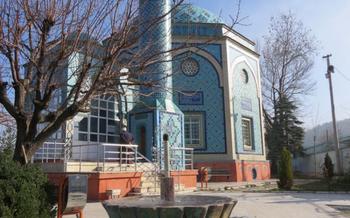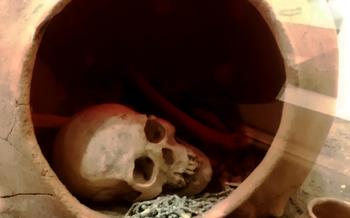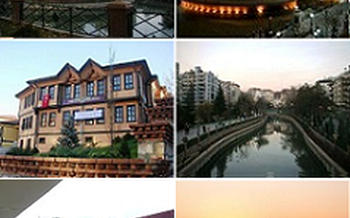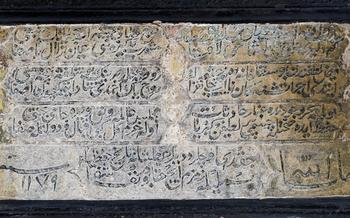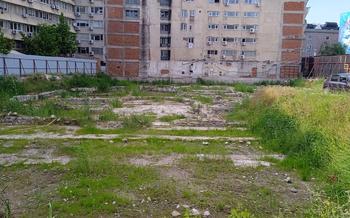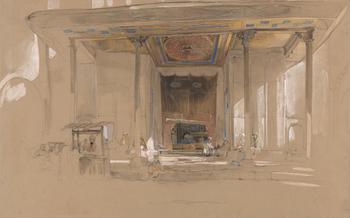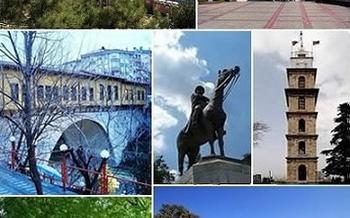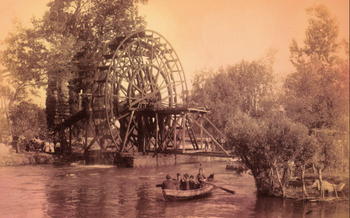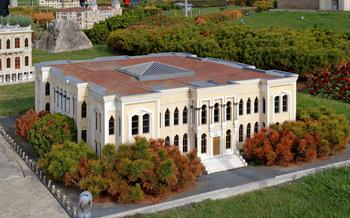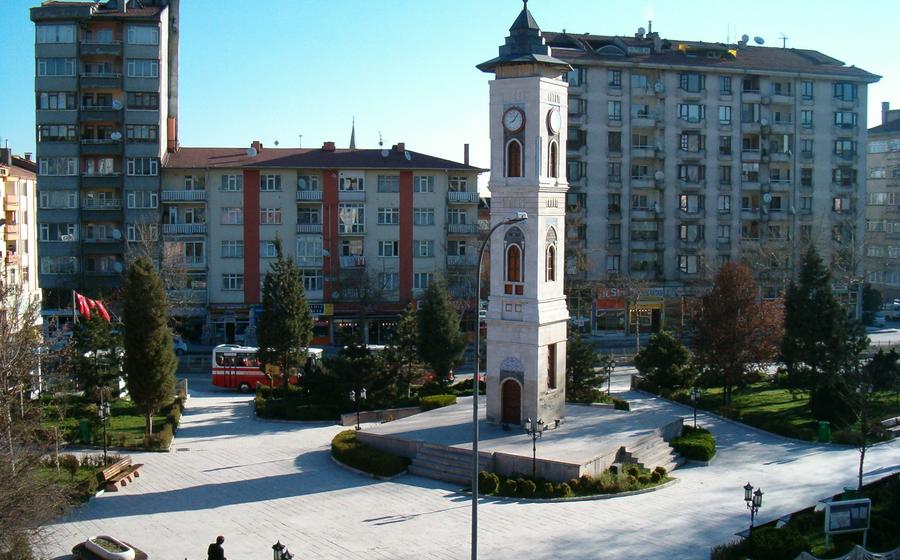
Kütahya Clock Tower
- The Antiquity of the City and its Clock Tower:
- Strategic Location of the Clock Tower
- Architectural Design of the Clock Tower
- Significance as a Symbol of Timekeeping
- Historical Context of Clock Towers in the Ottoman Empire
- Symbolism and Cultural Identity
- Panoramic Views from the Tower
- Restoration and Preservation Efforts
- The Clock Mechanism
- Visiting the Clock Tower:
- Exploring the Surroundings
- Local Cuisine and Delights
- Shopping and Local Crafts
- Insider Tip
- Cultural Events and Festivals
- Insider Tip: Unveiling the Hidden Gem of Kütahya
The Antiquity of the City and its Clock Tower:
Kütahya, known in ancient times as Cotyaeum, boasts a rich cultural heritage that dates back to the Phrygians, Lydians, and Persians. The city, strategically located along trade routes, flourished under the Roman and Byzantine empires, leaving behind a wealth of historical treasures. Among these, the Kütahya Clock Tower stands as a testament to the city's enduring legacy, a symbol of timekeeping and architectural mastery.
Built in the 19th century during the Ottoman era, the clock tower blends Ottoman and Seljuk architectural styles, reflecting the city's diverse cultural influences. Its construction marked a significant milestone in Kütahya's history, introducing modern timekeeping technology to the city and becoming an integral part of its urban landscape. Today, the clock tower stands as a protected cultural asset, a beloved landmark that continues to tell the story of Kütahya's rich past and its journey into modernity.
Strategic Location of the Clock Tower
The Kütahya Clock Tower stands tall and proud in the heart of the city's old town, serving as a prominent landmark and a gathering point for locals and visitors alike. Its central location, within the labyrinthine streets and historical buildings, makes it a natural reference point for navigation and exploration.
The clock tower's position offers a unique perspective of Kütahya's rich heritage. Surrounded by historical mosques, traditional Turkish houses, and bustling bazaars, the tower provides a glimpse into the city's past and present. Visitors can wander through the narrow streets, discovering hidden gems and immersing themselves in the vibrant atmosphere of the old town.
From the clock tower's vantage point, visitors can spot other notable landmarks, such as the Kütahya Castle, the Grand Mosque, and the Germiyan Bedesteni (covered market). These landmarks, each with their own unique story to tell, contribute to the area's charm and historical significance.
The tower's visibility from various parts of the city makes it an iconic symbol of Kütahya. Its towering presence can be seen from afar, inviting visitors to explore the city's hidden treasures. Whether strolling along the cobblestone streets or admiring the panoramic views from the castle, the clock tower remains a constant companion, guiding visitors through their journey in this enchanting city.
Architectural Design of the Clock Tower
The architectural style of the Kütahya Clock Tower is a harmonious blend of Ottoman and Seljuk influences, reflecting the rich cultural heritage of the region. Constructed primarily of durable stone and brick, the tower stands tall and sturdy, defying the passage of time. Its exterior is adorned with intricate carvings, decorative elements, and inscriptions in Arabic script, showcasing the artistry and craftsmanship of its builders.
The tower's base features a rectangular shape, transitioning into an elegant cylindrical form as it rises. The transition is marked by a series of decorative moldings and cornices, creating a visually appealing effect. The cylindrical section is further embellished with intricate carvings and geometric patterns, adding depth and texture to the tower's facade.
One of the most striking features of the tower is the presence of four clock faces, each facing a different direction to ensure visibility from all corners of the city. The clock faces are framed by decorative arches and supported by ornate brackets, adding to the overall grandeur of the structure.
Compared to other clock towers in Turkey, the Kütahya Clock Tower stands out for its unique combination of architectural elements. The blend of Ottoman and Seljuk styles, along with the intricate carvings and decorative details, sets it apart as a distinctive landmark that embodies the cultural heritage of Kütahya.
Significance as a Symbol of Timekeeping
The Kütahya Clock Tower served as the city's primary timekeeping device, playing a crucial role in the daily lives of its inhabitants. In an era before modern technology, accurate timekeeping was essential for coordinating various aspects of life, from religious observances to commercial transactions. The clock tower provided a standardized reference point for the entire community, ensuring that everyone was on the same page.
Traditional methods were employed to set and maintain the clock's accuracy. Skilled craftsmen would manually adjust the clock's hands based on astronomical observations, such as the position of the sun or stars. This required a deep understanding of celestial mechanics and a keen eye for precision. The clock's intricate mechanism, consisting of gears, weights, and a pendulum, was regularly inspected and maintained to ensure its smooth functioning.
The clock tower's synchronized timekeeping played a vital role in organizing community activities and events. It signaled the start and end of the working day, regulated market hours, and coordinated religious ceremonies. The rhythmic chimes of the clock echoed through the streets, serving as a constant reminder of the passage of time and the importance of punctuality.
Historical Context of Clock Towers in the Ottoman Empire
During the Ottoman Empire, clock towers held immense significance as symbols of modernization, progress, and urban planning. The construction of clock towers marked a shift towards embracing Western influences and incorporating new technologies into the empire's infrastructure. These structures served as essential tools for regulating time and coordinating daily activities within Ottoman cities.
The introduction of clock towers to the Ottoman Empire is attributed to Sultan Abdülmecid I, who initiated a comprehensive modernization program during his reign. The first clock tower in the empire was erected in Istanbul in 1848, followed by the construction of numerous other towers in major cities and towns across the empire.
Clock towers played a crucial role in urban planning. Their placement in central locations, often near mosques or other significant landmarks, ensured visibility and accessibility to the general public. The towers' prominent position helped synchronize daily life, enabling citizens to coordinate their activities and religious observances based on accurate timekeeping.
Clock towers also served as landmarks, contributing to the distinct cityscape of Ottoman cities. Their architectural designs often incorporated intricate details, reflecting the empire's rich artistic traditions. Some notable clock towers in Turkey include the Izmir Clock Tower, the Ankara Clock Tower, and the Bursa Clock Tower, each representing unique cultural and historical identities.
Symbolism and Cultural Identity
The Kütahya Clock Tower stands as a powerful symbol of the city's cultural identity, deeply embedded in the hearts and minds of its inhabitants. Its imposing presence serves as a constant reminder of Kütahya's rich history, architectural heritage, and enduring spirit. The clock tower has become an iconic landmark, evoking a sense of pride and belonging among locals, who cherish it as a symbol of their shared past and cultural legacy.
As a symbol of cultural continuity, the clock tower serves to connect the city's past with its present. It stands as a testament to the enduring traditions and heritage of Kütahya, while simultaneously representing the city's embrace of progress and modernity. The clock tower's ability to transcend time has made it a cherished symbol of resilience and adaptability, demonstrating the city's ability to evolve while preserving its cultural roots.
Moreover, the clock tower plays a significant role in promoting cultural tourism and attracting visitors interested in exploring Turkey's rich heritage. Its unique architectural style, historical significance, and panoramic views make it a must-see destination for those seeking to immerse themselves in the cultural tapestry of Kütahya. The clock tower serves as a gateway to the city's many other historical and cultural attractions, encouraging visitors to delve deeper into the region's rich past.
Throughout the years, the clock tower has become a focal point for local legends, stories, and traditions, further solidifying its status as a cultural icon. These tales, passed down through generations, add another layer of meaning and significance to the clock tower, weaving it into the fabric of Kütahya's cultural identity.
Panoramic Views from the Tower
The Kütahya Clock Tower stands tall and proud, offering visitors a unique opportunity to witness the city's stunning panoramic vistas. Ascend the winding staircase to the viewing platform and be rewarded with breathtaking views that stretch far and wide. From this elevated vantage point, you can gaze upon the city's iconic landmarks, including the Grand Mosque, the Kütahya Fortress, and the Porsuk River, which meanders through the urban landscape.
The clock tower's position at the heart of the old town provides an unparalleled perspective, allowing you to appreciate the city's historical and architectural heritage. Admire the intricate details of the Ottoman-era buildings, the vibrant colors of the traditional houses, and the bustling activity of the city's central square.
Beyond the urban landscape, the panoramic views extend to the surrounding natural beauty. Gaze upon the lush green hills that embrace Kütahya, dotted with olive groves and vineyards. On a clear day, you may even catch a glimpse of the distant Uludağ Mountain, whose snow-capped peak rises majestically in the horizon.
The 360-degree views from the clock tower offer a comprehensive understanding of Kütahya's geography and urban layout. It's a visual feast that allows you to immerse yourself in the city's past, present, and future. Whether you're a history buff, an architecture enthusiast, or simply a traveler seeking an unforgettable experience, the panoramic vistas from the clock tower are not to be missed.
Restoration and Preservation Efforts
The passage of time and exposure to the elements have inevitably left their mark on the Kütahya Clock Tower. However, thanks to the tireless efforts of dedicated individuals and organizations, the tower has undergone several restoration and preservation projects to maintain its structural integrity and architectural beauty.
One of the most significant restoration efforts was undertaken in the late 20th century when the tower's exterior was thoroughly cleaned and repaired. Skilled artisans meticulously restored the intricate carvings and decorative elements, ensuring that the tower's original splendor was preserved for future generations.
In addition, the clock mechanism itself has been meticulously maintained and serviced over the years. Expert horologists have worked diligently to keep the clock functioning accurately, ensuring that it continues to chime the hour and mark the passage of time for the people of Kütahya.
These restoration and preservation efforts are crucial in ensuring the longevity of the clock tower and its continued status as a symbol of Kütahya's rich history and cultural heritage. By preserving this architectural gem, the city safeguards a tangible link to its past while ensuring that future generations can continue to admire its beauty and appreciate its significance.
The Clock Mechanism
The Kütahya Clock Tower houses an intricate clock mechanism that is a testament to the ingenuity and craftsmanship of its creators. The clock's inner workings consist of a complex system of gears, weights, and a pendulum, all working in harmony to provide accurate timekeeping.
The clock's gears are made of durable metal and are designed to interlock precisely, ensuring smooth and continuous operation. The weights, suspended by ropes or chains, provide the power to drive the clock's mechanism. As the weights descend, they pull on the gears, causing them to rotate and advance the hands of the clock.
The pendulum, a crucial component of the clock, regulates its rhythm and ensures its accuracy. It swings back and forth, providing a steady beat that governs the movement of the gears and hands. The pendulum's length and weight are carefully calibrated to ensure that the clock keeps precise time.
The maintenance and upkeep of the clock mechanism require specialized knowledge and skill. Regularly winding the weights, lubricating the gears, and adjusting the pendulum are essential tasks to ensure the clock's continued operation. The clock's intricate mechanism is a reminder of the importance of precision and craftsmanship in the art of timekeeping.
Visiting the Clock Tower:
To fully appreciate the grandeur of the Kütahya Clock Tower and its historical significance, visiting this iconic landmark is a must. The tower is conveniently located in the heart of the city, making it easily accessible by foot or public transportation. While there are no entrance fees or restrictions, visitors are advised to be respectful of the tower's cultural and historical importance.
The best time to visit the clock tower is during the late afternoon or early evening, when the setting sun casts a warm glow on the tower's facade, creating a picturesque scene. Visitors can climb the tower's spiral staircase to reach the viewing platform, where they are rewarded with breathtaking panoramic views of the city. From this vantage point, one can admire the intricate rooftops, historical monuments, and the bustling city life below.
For those seeking a deeper understanding of the clock tower's history and significance, guided tours are available upon request. These tours provide insights into the tower's construction, its role in the city's development, and the fascinating stories associated with it. Historical information panels and brochures are also available for visitors who prefer to explore at their own pace.
Whether you're a history buff, an architecture enthusiast, or simply a curious traveler, a visit to the Kütahya Clock Tower promises an unforgettable experience. Immerse yourself in the rich heritage of this ancient city and let the clock tower transport you back in time to an era of grandeur and precision.
Exploring the Surroundings
Beyond the captivating allure of the Kütahya Clock Tower, the surrounding area beckons visitors to delve deeper into the city's rich tapestry of history and culture. A short stroll from the clock tower, the Kütahya Museum invites visitors to explore the region's archaeological treasures, showcasing artifacts that narrate the story of Kütahya's ancient past. The museum's collection includes intricate pottery, sculptures, and inscriptions that provide glimpses into the lives and traditions of the city's former inhabitants.
Continuing along the cobblestone streets, visitors will encounter the Grand Mosque of Kütahya, a magnificent architectural masterpiece that stands as a testament to the city's Islamic heritage. Built in the 15th century, the mosque features stunning tilework, intricate carvings, and a serene courtyard that offers a tranquil oasis amidst the bustling city. Visitors can admire the mosque's graceful minarets, which rise majestically towards the sky, symbolizing the city's deep-rooted spiritual traditions.
For those seeking a taste of local culture, the traditional Turkish bathhouses, known as hamams, offer a unique and rejuvenating experience. Located a short distance from the clock tower, these hamams provide visitors with an opportunity to immerse themselves in the soothing steam, relax in the warm marble chambers, and indulge in a traditional massage. The hamams are not only places of cleansing but also serve as social hubs where locals gather to socialize and unwind.
As the sun begins to set, visitors can wander through the vibrant streets of Kütahya, where the air fills with the tantalizing aromas of traditional Turkish cuisine. Local restaurants and eateries, nestled amidst charming alleys, offer a delectable array of dishes that showcase the region's culinary heritage. Visitors can savor the flavors of freshly grilled kebabs, indulge in the rich taste of Turkish delight, and sip on aromatic Turkish coffee, immersing themselves in the city's vibrant culinary scene.
Local Cuisine and Delights
Kütahya's culinary scene is a delightful blend of traditional flavors and unique ingredients, reflecting the region's rich cultural heritage. Visitors can savor a variety of local delicacies that showcase the city's culinary prowess.
One must-try dish is "Kuyu Kebabı," a tender lamb dish cooked slowly in an underground oven, resulting in a succulent and flavorful experience. "Ekşili Köfte," a dish of meatballs simmered in a tangy sauce, is another local favorite, offering a burst of flavors.
For a taste of traditional Turkish cuisine, visitors can indulge in "Mantı," delicate dumplings filled with minced meat and topped with garlic-yogurt sauce. "Keskek," a hearty dish made from pounded wheat, meat, and spices, is another local specialty that showcases the region's culinary traditions.
To satisfy a sweet tooth, visitors can try "Kütahya Porselen Çikolatası," a unique chocolate that combines the city's renowned porcelain craftsmanship with the rich taste of chocolate. "Revani," a semolina cake soaked in syrup, is another popular dessert that offers a delightful balance of sweetness and texture.
Several restaurants and eateries near the clock tower offer a chance to sample these local delights. "Tarihi Saat Kulesi Lokantası" is a charming establishment serving traditional Turkish cuisine with a stunning view of the clock tower. "Kütahya Mantı Evi" is renowned for its delicious mantı, while "Keskek Evi" specializes in the hearty keskek dish.
Shopping and Local Crafts
Kütahya is a treasure trove for those seeking unique souvenirs and traditional crafts. The city's vibrant shopping scene offers a diverse range of authentic products that reflect its rich cultural heritage. Visitors can explore the narrow streets and bustling markets surrounding the clock tower to discover an array of handcrafted items.
One of Kütahya's specialties is its exquisite pottery, renowned for its intricate designs and vibrant colors. Visitors can find a wide selection of ceramic pieces, from decorative plates and vases to unique tiles and figurines. The city is also known for its high-quality textiles, including hand-woven carpets, rugs, and embroidered fabrics. These intricate textiles showcase the skill and artistry of local artisans, making them treasured souvenirs for visitors.
In addition to pottery and textiles, Kütahya offers a variety of other traditional crafts. Visitors can find hand-carved wooden items, such as decorative boxes, frames, and sculptures. There are also numerous shops selling handmade jewelry, accessories, and souvenirs made from local materials.
When shopping in Kütahya, it's important to remember that bargaining is a common practice. Visitors can engage in friendly negotiations with shopkeepers to obtain the best prices. However, it's essential to be respectful and mindful of local customs and traditions while bargaining.
Insider Tip
For a truly unique shopping experience, visitors should explore the hidden gem of the "Hidden Bazaar," located just a short walk from the clock tower. This charming bazaar offers a glimpse into traditional Turkish shopping culture, with narrow alleys lined with small shops selling a variety of goods. Visitors can find everything from vintage clothing and antique jewelry to handmade crafts and souvenirs. The Hidden Bazaar is a great place to discover hidden treasures and experience the authentic atmosphere of Kütahya's shopping scene.
Cultural Events and Festivals
Kütahya comes alive with cultural events and festivals throughout the year, showcasing the city's rich heritage and traditions. One of the most significant events is the Kütahya Porcelain Festival, held annually to celebrate the city's renowned porcelain production. Visitors can witness live demonstrations by skilled artisans, admire exquisite porcelain exhibits, and purchase unique handmade pieces. The festival is a vibrant display of Kütahya's craftsmanship and a must-see for anyone interested in Turkish ceramics.
Another popular event is the Kütahya Music Festival, featuring performances by local and international musicians. Held in the summer months, the festival fills the city's streets with the sounds of traditional Turkish music, contemporary melodies, and international beats. Visitors can enjoy live concerts, workshops, and dance performances, immersing themselves in the city's vibrant music scene.
For those interested in history and culture, the Kütahya History and Culture Festival offers a glimpse into the city's past. Held annually, the festival features exhibitions, conferences, and reenactments that bring to life Kütahya's rich history. Visitors can explore ancient artifacts, learn about traditional customs, and witness historical performances that showcase the city's diverse cultural heritage.
Insider Tip: Unveiling the Hidden Gem of Kütahya
Amidst the bustling streets of Kütahya, tucked away just a stone's throw from the majestic clock tower, lies a hidden gem waiting to be discovered by curious travelers.
Follow the narrow cobblestone path that leads you through a charming alleyway, past traditional Ottoman houses and vibrant shops displaying colorful handicrafts. As you approach the end of the alley, you'll find yourself in a secluded courtyard, where a centuries-old mosque stands proudly, its minaret reaching towards the sky.
This hidden mosque, known only to locals and a few fortunate visitors, offers a serene oasis amidst the city's vibrant energy. Step inside, and you'll be greeted by intricate tilework, elegant calligraphy, and a palpable sense of history. Take a moment to admire the architectural details and soak in the tranquility of this sacred space.
After exploring the mosque, make your way to the courtyard, where you'll find a charming tea garden hidden among lush greenery. Order a cup of freshly brewed Turkish tea and relax on the cushioned benches, surrounded by the gentle sound of water trickling from a nearby fountain.
As you sip your tea, take in the beauty of the mosque's exterior, its domes and minarets bathed in warm sunlight. This hidden gem is the perfect place to escape the hustle and bustle of the city and experience a moment of tranquility and reflection.
